1、网络编程概述

1.1、网络基础

2、网络通信要素概述(通信双方地址+一定的规则)

2.1、如何实现网络中的主机相互通信:IP+端口号
2.1.1、IP地址的理解
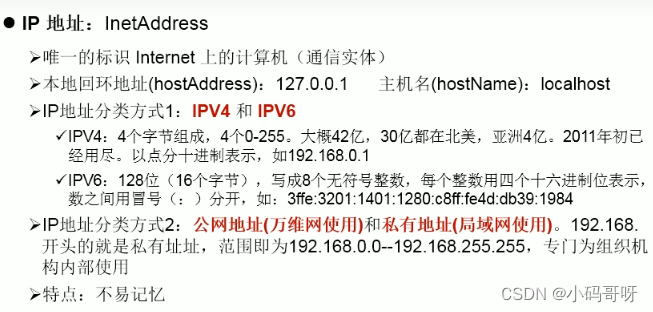
2.1.2、InetAddress类的实例化
public class InetAddressTest {
//如何实例化InetAddress:两个方法:getByName(String host)、getLoalHost()
public static void main(String[] args) {
try {
InetAddress inet1 = InetAddress.getByName("192.168.0.154");
System.out.println(inet1);
System.out.println("==============================");
InetAddress inet2 = InetAddress.getByName("www.baidu.com");
System.out.println(inet2);
System.out.println("==============================");
//获取本机ip
InetAddress localhost = InetAddress.getLocalHost();
System.out.println(localhost);
System.out.println("==============================");
System.out.println(inet2.getHostName());
System.out.println(inet2.getHostAddress());
} catch (UnknownHostException e) {
e.printStackTrace();
}
}
}
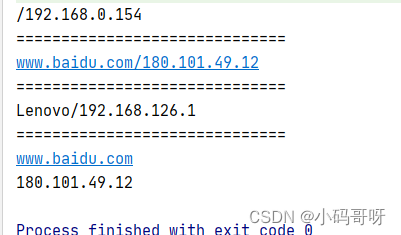
2.1.3、端口号
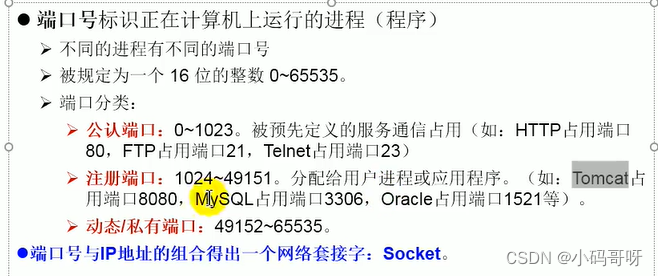
2.2、网络通信协议
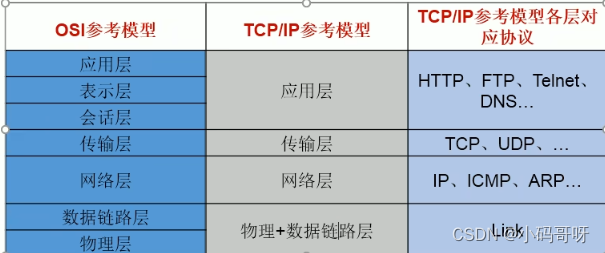
2.2.1、网络通信协议
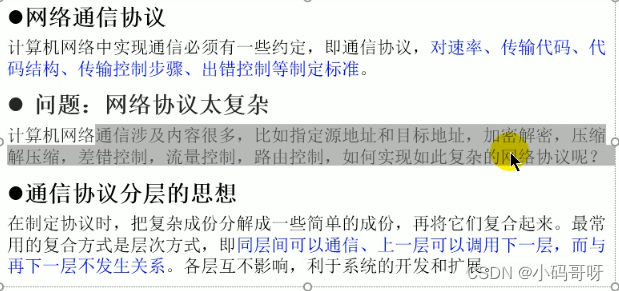
2.2.2、TCP/IP协议簇

2.2.3、TCP和UDP
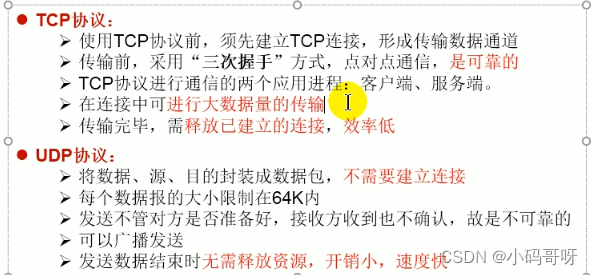

2.2.4、建立链接时的三次握手

2.2.5、释放连接时的四次挥手
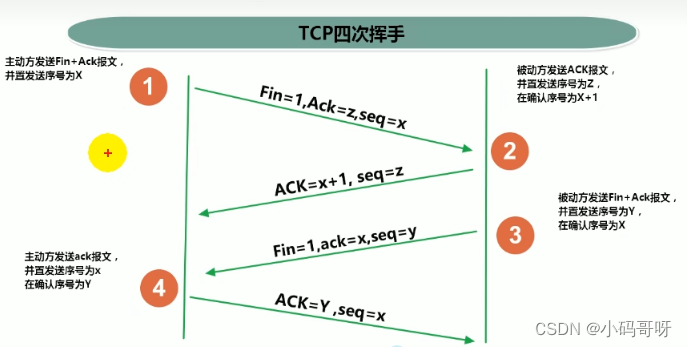

3、TCP网络编程例题
先启动服务端,在启动客户端
3.1、客户端发送内容给服务端,服务端将内容打印在控制台上
public class TcpTest {
//客户端
@Test
public void client(){
Socket socket = null;
OutputStream os = null;
try {
//1、创建Socket对象,指明服务器的ip和端口号
InetAddress inet = InetAddress.getByName("127.0.0.1");
socket = new Socket(inet,8899);
//2、获取一个输出流,用于输出数据
os = socket.getOutputStream();
//3、写书数据
os.write("你好,我是客户端".getBytes());
} catch (IOException e) {
e.printStackTrace();
} finally {
//4、资源关闭
if(os!=null){
try {
os.close();
} catch (IOException e) {
e.printStackTrace();
}
}
if(socket!=null){
try {
socket.close();
} catch (IOException e) {
e.printStackTrace();
}
}
}
}
@Test
public void server(){
ServerSocket ss = null;
Socket socket = null;
InputStream is = null;
ByteArrayOutputStream baos = null;
try {
//1、创建ServerSocket对象,指明自己的端口号
ss = new ServerSocket(8899);
//2、调用accept()表示接收来自于客户端的socket
socket = ss.accept();
//3获取输入路
is = socket.getInputStream();
//4、读取输入流中的数据
baos = new ByteArrayOutputStream();
byte[] buffer = new byte[5];
int len;
while((len = is.read(buffer))!=-1){
baos.write(buffer,0,len);
}
System.out.println(baos.toString());
} catch (IOException e) {
e.printStackTrace();
} finally {
//5、关闭资源
if(baos!=null){
try {
baos.close();
} catch (IOException e) {
e.printStackTrace();
}
}
if(baos!=null){
try {
is.close();
} catch (IOException e) {
e.printStackTrace();
}
}
if(baos!=null){
try {
socket.close();
} catch (IOException e) {
e.printStackTrace();
}
}
if(baos!=null){
try {
ss.close();
} catch (IOException e) {
e.printStackTrace();
}
}
}
}
}
3.2、客户端发送文件给服务端,服务端将文件保存到本地
public class TcpTest02 {
//客户端
@Test
public void client(){
Socket socket = null;
OutputStream os = null;
FileInputStream fis = null;
try {
socket = new Socket(InetAddress.getByName("127.0.0.1"),9090);
os = socket.getOutputStream();
fis = new FileInputStream(new File("bird.png"));
byte[] buffer = new byte[20];
int len;
while((len = fis.read(buffer))!=-1){
os.write(buffer,0,len);
}
} catch (IOException e) {
e.printStackTrace();
} finally {
if(fis!=null){
try {
fis.close();
} catch (IOException e) {
e.printStackTrace();
}
}
if(os!=null){
try {
os.close();
} catch (IOException e) {
e.printStackTrace();
}
}
if(socket!=null){
try {
socket.close();
} catch (IOException e) {
e.printStackTrace();
}
}
}
}
//服务端
@Test
public void server(){
ServerSocket ss = null;
Socket socket = null;
InputStream is = null;
FileOutputStream fos = null;
try {
ss = new ServerSocket(9090);
socket = ss.accept();
is = socket.getInputStream();
fos = new FileOutputStream(new File("bird1.png"));
byte[] buffer = new byte[20];
int len;
while ((len = is.read(buffer))!=-1){
fos.write(buffer,0,len);
}
System.out.println("接收成功!");
} catch (IOException e) {
e.printStackTrace();
} finally {
if(fos!=null){
try {
fos.close();
} catch (IOException e) {
e.printStackTrace();
}
}
if(is!=null){
try {
is.close();
} catch (IOException e) {
e.printStackTrace();
}
}
if(socket!=null){
try {
socket.close();
} catch (IOException e) {
e.printStackTrace();
}
}
if(ss!=null){
try {
ss.close();
} catch (IOException e) {
e.printStackTrace();
}
}
}
}
}
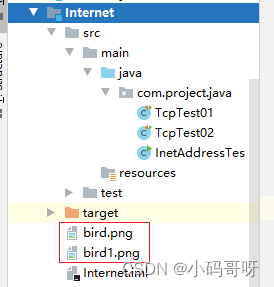
3.3、客户端发送文件给服务端,服务端将文件保存到本地。并返回发送成功给客户端。并关闭相应连接
public class TcpTest03 {
//客户端
@Test
public void client(){
Socket socket = null;
OutputStream os = null;
FileInputStream fis = null;
ByteArrayOutputStream baos = null;
try {
socket = new Socket(InetAddress.getByName("127.0.0.1"),9090);
os = socket.getOutputStream();
fis = new FileInputStream(new File("bird.png"));
byte[] buffer = new byte[20];
int len;
while((len = fis.read(buffer))!=-1){
os.write(buffer,0,len);
}
//图片传完,关闭图片的传输
socket.shutdownOutput();
//5、接收来自于服务端的数据,打印倒控制台上
InputStream is = socket.getInputStream();
baos = new ByteArrayOutputStream();
byte[] buffer1 = new byte[20];
int len1;
while((len1 = is.read(buffer1))!=-1){
baos.write(buffer1,0,len1);
}
System.out.println(baos.toString());
} catch (IOException e) {
e.printStackTrace();
} finally {
if(fis!=null){
try {
fis.close();
} catch (IOException e) {
e.printStackTrace();
}
}
if(os!=null){
try {
os.close();
} catch (IOException e) {
e.printStackTrace();
}
}
if(socket!=null){
try {
socket.close();
} catch (IOException e) {
e.printStackTrace();
}
}
if(baos!=null){
try {
baos.close();
} catch (IOException e) {
e.printStackTrace();
}
}
}
}
//服务端
@Test
public void server(){
ServerSocket ss = null;
Socket socket = null;
InputStream is = null;
FileOutputStream fos = null;
OutputStream os = null;
try {
ss = new ServerSocket(9090);
socket = ss.accept();
is = socket.getInputStream();
fos = new FileOutputStream(new File("bird2.png"));
byte[] buffer = new byte[20];
int len;
while ((len = is.read(buffer))!=-1){
fos.write(buffer,0,len);
}
os = socket.getOutputStream();
os.write("你好,客户端,照片我已接收(---来自于服务端)".getBytes());
} catch (IOException e) {
e.printStackTrace();
} finally {
if(fos!=null){
try {
fos.close();
} catch (IOException e) {
e.printStackTrace();
}
}
if(is!=null){
try {
is.close();
} catch (IOException e) {
e.printStackTrace();
}
}
if(socket!=null){
try {
socket.close();
} catch (IOException e) {
e.printStackTrace();
}
}
if(ss!=null){
try {
ss.close();
} catch (IOException e) {
e.printStackTrace();
}
}
if(os!=null){
try {
os.close();
} catch (IOException e) {
e.printStackTrace();
}
}
}
}
}

4、UDP网络通信

UDP通信特点:发送端只管发送,不管接收端是否接收成功。如果发送端发送出去数据,但接收端没有接收到数据,那么发送端也不会报错。
public class UDPTest {
//发送端
@Test
public void sender() throws IOException {
DatagramSocket socket = new DatagramSocket();
String str = "我是UDP方式发送的导弹";
byte[] data = str.getBytes();
InetAddress inet = InetAddress.getLocalHost();
DatagramPacket packet = new DatagramPacket(data,0,data.length,inet,9090);
socket.send(packet);
socket.close();
}
//接收端
@Test
public void receiver() throws IOException {
DatagramSocket socket = new DatagramSocket(9090);
byte[] buffer = new byte[100];
DatagramPacket packet = new DatagramPacket(buffer,0,buffer.length);
socket.receive(packet);
System.out.println(new String(packet.getData(),0,packet.getLength()));
socket.close();
}
}
5、URL类的理解与实例化
5.1、URL类
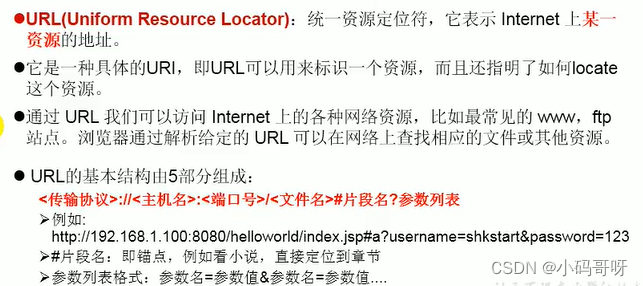
5.2、URL类构造器
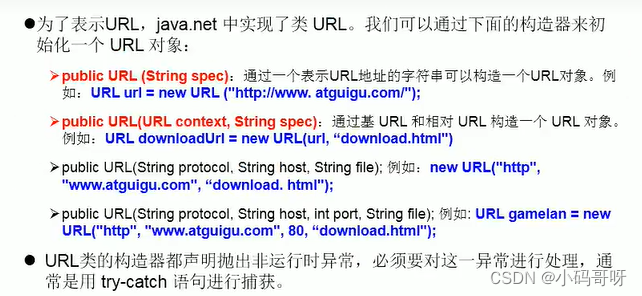
5.3、URL类常用方法

/**
* URL网络编程
* 1、URL:统一资源定位符、,对应着互联网的而谋一资源地址
* 2、格式:
* http://localhost:8080/example/beauty.jpg?username=tom
* 协议 主机名 端口号 资源地址 参数列表
*/
public class URLTest {
public static void main(String[] args) {
try {
URL url = new URL("http://localhost:8080/example/beauty.jpg?username=tom");
System.out.println(url.getProtocol());//获取该URL的协议名
System.out.println(url.getHost());//获取该URL的主机名
System.out.println(url.getPort());//获取该URL的端口号
System.out.println(url.getPath());//获取该URL的文件路径
System.out.println(url.getFile());//获取该URL的文件名
System.out.println(url.getQuery());//获取该URL的查询名
} catch (MalformedURLException e) {
e.printStackTrace();
}
}
}

5.4、URL编程实现从Tomcat服务器上拿资源
前提:启动本机tomcat服务器,在example文件夹下有bird.png文件
public class URLTest2 {
public static void main(String[] args){
HttpURLConnection urlConnection = null;
InputStream is = null;
FileOutputStream fos = null;
try {
URL url = new URL("http://localhost:8080/example/bird.png");
urlConnection = (HttpURLConnection) url.openConnection();
urlConnection.connect();
is = urlConnection.getInputStream();
fos = new FileOutputStream("bird2.png");
byte[] buffer = new byte[1024];
int len;
while((len =is.read())!=-1){
fos.write(buffer,0,len);
}
System.out.println("下载完成");
} catch (IOException e) {
e.printStackTrace();
} finally {
if(is!=null){
//关闭资源
try {
is.close();
} catch (IOException e) {
e.printStackTrace();
}
}
if(fos!=null){
try {
fos.close();
} catch (IOException e) {
e.printStackTrace();
}
}
if(urlConnection!=null){
//关闭资源
urlConnection.disconnect();
}
}
}
}






















 5874
5874











 被折叠的 条评论
为什么被折叠?
被折叠的 条评论
为什么被折叠?








